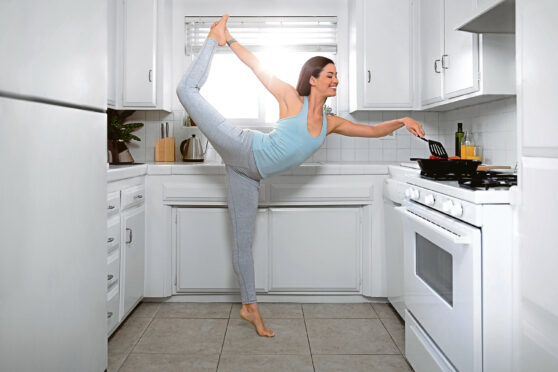
Getting healthy can often sound like a huge mountain to climb, especially if you’re not used to exercising or have difficultly with your mobility.
But while long-term good health takes consistent effort, there are many little things you can do in not very much time – and easily – to help boost your health.
“Keeping our physical and mental wellbeing intact can feel like an impossible task,” says Melissa Snover, registered nutritionist and founder of Nourished (get-nourished.com). “We’re constantly trying to offset the impact of our hectic modern lifestyles – in particular, the detrimental effects of stress, overworking, lack of sleep and poor diet.
“The good news is there are plenty of quick, simple things we can do every day to improve our wellbeing,” she adds. “The key is consistency – start off by incorporating just one or two healthy habits into your daily routine, and repeat, until it feels instinctive.”
The message to keep in mind is “every little helps”. Here are eight easy ways you can improve your body and mind in just 10 minutes…
1. Use your muscles while the kettle boils
While you make your morning brew, use the time to work some muscles. “There’s a 60-second window you can utilise while the kettle boils – take the first 30 to do some calf raises, and for the remainder do a quick wall sit,” suggests Dr Luke Powles, clinical director at Bupa Health Clinics (bupa.co.uk). “These are exercises that won’t break a sweat, but doing them daily, you’ll start to see results after a couple of weeks.”
2. Stand up
Powles points out that just standing can burn more calories than sitting – and every little helps. How about standing up every time you take a call at work or at home? “If you’re on your mobile, take the call outside and walk,” suggests Powles. “You won’t realise just how many steps you take, even if it’s around the office block.
“Or, when you’ve completed a section of tasks, take 100 steps in one direction and then take 100 steps back. This will give your mind a break, move your body, and get some oxygen to the brain.”
3. Drink a glass of water
Dehydration can impact the balance of dopamine and serotonin in the brain, which can increase feelings of low mood, anxiety or depression, says Snover. “Hydration is also needed for normal digestion, temperature control, brain function and encouraging good circulation, which is why it’s imperative we fuel our bodies with enough water throughout the day.”
The NHS Eatwell Guide recommends drinking six to eight glasses each day, which is around 1.2-1.5 litres. As well as water, Snover says other liquids that qualify include low-fat milk and sugar-free drinks, including tea and coffee.
4. Stretch
Sitting for long periods can leave our bodies uncomfortable, make us less productive, and isn’t good for health, explains Powles, who suggests doing some simple stretches, whether you’re at home or at your desk. “Keeping your body stretched will do the world of good and will avoid stiffness,” he promises.
5. Eat some protein
Protein is the “building block’” of our bodies, and diets high in protein – including foods such as eggs, chickpeas, yoghurt, nuts and seeds – are linked to a range of benefits, says Snover. These range from quicker recovery from injuries, lower blood pressure, good bone health and greater muscle strength and mass, to less intense food cravings.
“There’s growing research linking a high protein intake to better metabolic health and, in turn, weight management,” adds Snover, who says protein increases hormones which make us feel full and reduces “hunger hormones”, helping us feel satisfied for longer.
6. Exercise in the ad breaks
If you can’t make it to the gym, or would just rather slouch in front of the telly, why not get the best of both worlds? “Take your favourite hour-long programme and plan exercises for each ad break,” suggests Powles. “Say each ad is 60 seconds, try 20 seconds of squats, 20 seconds of lunges and 20 seconds of high knees. Do this three times, which will make those boring ad breaks fly by!”
7. Move while the bath runs
As you wait for the bath to fill up, Powles suggests you walk up and down your stairs as many times as possible. “If you don’t have stairs, standing rotated lunges will work just fine,” he says. “But just make sure to peek into the bathroom to ensure there are no spillages!”
8. Get some sunshine
Vitamin D helps keep bones, teeth and muscles healthy, among other important things for good general health – and the body creates it from exposure to direct sunlight when outdoors, when there’s sufficient conditions. In the UK, from about late March/early April to the end of September, the majority of people should be able to make all the vitamin D from being outdoors in the sunshine.
During the autumn and winter, you need to get vitamin D from your diet (red meats, eggs, oily fish are good sources) or take a daily supplement. But the spring and summer months are a great time to (safely!) soak up those rays – so get out for a morning or lunch time stroll. Your mood will benefit, too.

Enjoy the convenience of having The Sunday Post delivered as a digital ePaper straight to your smartphone, tablet or computer.
Subscribe for only £5.49 a month and enjoy all the benefits of the printed paper as a digital replica.
Subscribe